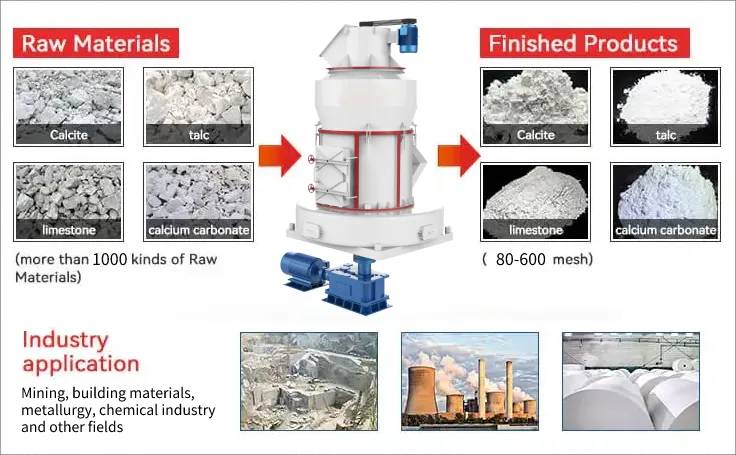Comparison of Dry Grinding and Wet Grinding Processes of Desulfurized Limestone Pulverization
With the rapid development of the power industry, the demand for desulfurized limestone powder is gradually increasing. In order to achieve high-quality desulfurized limestone powder preparation, it is necessary to choose the correct production process. This article compares and introduces the preparation process of desulfurized limestone powder.
Limestone powder preparation common process and equipment
The desulfurization system is divided into 4 areas according to the process area: limestone grinding area, limestone slurry preparation area, absorption tower area and gypsum dehydration area. Limestone grinding is an important first process in the desulfurization process. There are two types of limestone powder preparation processes, dry grinding system and wet grinding system.
1. Dry grinding
The technological process of the dry grinding system is: limestone enters the dry mill from the silo, and is ground into limestone powder of 250-325 mesh (according to American Taylor standard, about 0.061-0.043mm), which is collected into limestone slurry by bag vacuum cleaner. Prepare powder bin. The limestone powder in the powder bin is quantitatively distributed to the limestone slurry tank by the feeding device, and mixed with water to make a certain concentration of limestone slurry, and then transported to the absorption tower by the slurry pump.
The main equipment of the dry grinding system is a vertical roller mill, which integrates fine crushing, drying, grinding, powder selection, and transportation. It has high grinding efficiency, low power consumption, large drying capacity, and easy adjustment of product fineness. Simple process, small footprint, low noise, no dust pollution, low wear, easy maintenance, reliable operation, etc.

2. Wet grinding
The process flow of the wet grinding system is as follows: limestone is mixed with water in the wet mill, and directly ground into limestone slurry, which is transported to the hydraulic rotator by the pump for separation. The qualified granular limestone slurry enters the limestone slurry tank, and then passes through the slurry pump. It is sent to the absorption tower, and the unqualified large-grained limestone slurry is sent back to the mill for grinding, and the cycle runs like this.
The main equipment of the wet grinding system is the wet ball mill, which is still a widely used limestone pulping equipment in the operation of the desulfurization system.
Comparison of dry grinding and wet grinding
1. The system layout is different
The dry milling system and the pulping system are independent of each other, and the distance between the pulping area and the milling area is not limited, which is especially suitable for the needs of large output and concentrated preparation of absorbent. It is especially suitable for renovation projects, which can make the general layout more flexible.
The wet grinding system and the pulping system are interrelated. Generally, the distance between the limestone grinding area and the slurry tank should not be too far. The system needs to be cleaned regularly. The portion is huge.
2. Different equipment investment costs
The dry milling system has a simple process flow, compact layout, and small building area. The floor area is about 70% of the horizontal dry milling system, and the building space is about 60% of the wet milling system and can be arranged in the open air. Directly reduce the cost of enterprise investment. The dry mill itself has a separator, so there is no need for additional separators and lifting equipment. The dusty gas from the mill can be directly collected by a bag filter or an electric dust collector. According to the quotation of the mill manufacturer, the price of the wet mill is about 10% higher than that of the dry mill.
3. Large differences in process design
The dry grinding process is simple, and the floor area and space occupied are small. It has a powder separator itself, and no additional powder separator and lifting equipment are needed. The dusty gas from the mill can be directly collected by a high-concentration bag filter or an electric precipitator, so the process is simple, the layout is compact, and it can be arranged in the open air. The wet ball mill does not have the above advantages.
4. Differences in product quality
The chemical composition of the product is stable and the particle gradation is uniform, which is conducive to calcination. The time for materials to stay in the vertical dry mill is only 2 to 3 minutes, while in the wet ball mill it takes 15 to 20 minutes. Therefore, the chemical composition and fineness of vertical dry grinding products can be quickly measured and corrected.
5. Different maintenance costs
The wet grinding process requires a lot of system maintenance work, pipeline wear and regular cleaning workload, which will inevitably increase the cost.
Wet mill grinding system requires nearly 10% more investment than using dry mill grinding system. However, various technical and economic indicators are lower than those of the dry grinding system. Especially the power consumption per unit product, the dry grinding system is 40% lower than the wet grinding system. It can be seen that the dry grinding system is far lower than the wet ball mill grinding system in terms of technical index value and economic index.
